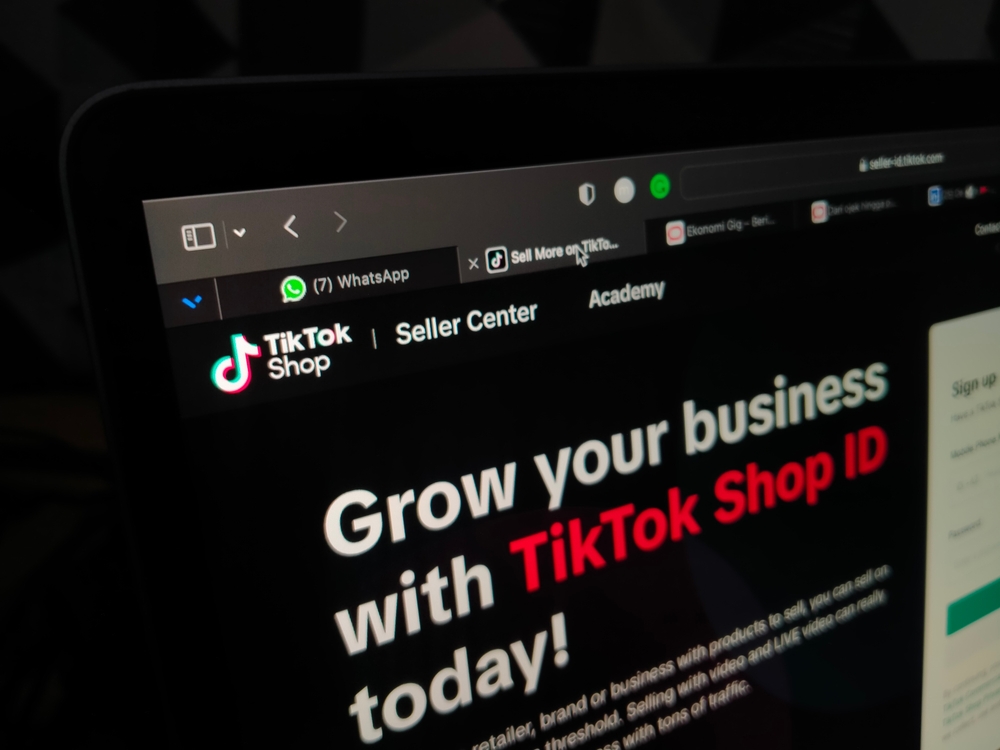TikTok has rapidly transformed from a viral video platform into a significant player in the sphere of social commerce, revolutionizing the online shopping paradigm. This platform, with its robust e-commerce strategy, has managed to build an influential presence that is reshaping the way businesses and consumers interact with each other. This unique approach has not only revolutionized the marketing landscape but has also altered consumer buying behavior, particularly in the United States.
While initially slower to be adopted in the U.S., social commerce has seen rapid growth, with TikTok leading the charge. With its innovative, personalized, and entertaining strategies, TikTok is reshaping the landscape of online shopping in the U.S. Looking particularly at the younger demographics, TikTok’s U.S. user base is set to surpass 73 million by 2023, according to eMarketer. This highlights the platform’s potential and influence, making it a vital tool for any business looking to target and engage with consumers in the States.
TikTok’s Meteoric Rise in Social Commerce
The genius behind TikTok’s e-commerce strategy lies in its seamless blending of shopping and entertainment. Creating an environment where purchasing decisions are influenced by a personalized feed of entertaining content. This unique approach, dubbed ‘shoppertainment’, has led to exponential growth in the platform’s user base, each spending an average of 52 minutes per day on the app according to a 2020 report by Oberlo.
The rapid growth of social commerce, particularly on TikTok, is well-supported by statistical data. According to a report by Business of Apps, TikTok generated approximately $500 million in revenue in the U.S in 2020, a significant part of which came from its ecommerce business.
Furthermore, a survey by Piplsay indicated that about 42% of TikTok users have purchased something they discovered on the platform (source: [Piplsay](https://piplsay.com/)). This data is a strong testament to the platform’s potential as a social commerce site and a testament to its efficient ecommerce strategy.
Moreover, these trends are not just limited to the U.S. Emarketer forecasts that China’s social commerce sales will rise by 35.5% to $363.26 billion in 2021, and TikTok is one of the significant contributors to this growth.
Fuelled by an intelligent algorithm that capitalizes on user preferences, TikTok presents a non-linear retail path that breaks the traditional e-commerce mold. Consumers are engaged at multiple levels and stages of their shopping journey, from brand discovery to post-purchase conversations, all within one app. This strategy is a masterstroke in enhancing customer interactions and refining the overall purchasing experience.
How Has TikTok Changed Marketing
One significant way TikTok’s e-commerce strategy has reshaped the online marketing landscape is through the rise and effective use of user-generated content (UGC). By leveraging UGC, TikTok has managed to turn regular users into brand ambassadors through their personalized content and consumer reviews. This approach, widely known as ‘Influencer Marketing,’ has transformed the way businesses interact with and market to their customers, proving to be a highly effective driver for product discovery and conversion.
Furthermore, TikTok’s ‘shoppable’ videos feature, allowing creators to tag products in their videos, leading directly to the product’s purchase page, has set the stage for a revolution in online shopping. This innovation reduces the gap between discovering a product and purchasing it, providing an overall boost to the conversion rate.

E-commerce Strategy on TikTok
TikTok’s e-commerce strategy revolves around understanding and catering to the ever-changing dynamics of the consumer market. Their tools such as the TikTok Shopping partnership with Shopify, enable businesses to seamlessly sell their products within the app. This not only decreases the customer journey’s complexity but also enhances the shopping experience, further driving consumer engagement and loyalty.
From live shopping events to ‘Shop Now’ buttons on viral videos, TikTok has capitalized on the impulsive nature of consumers. Encouraging spontaneous purchases by integrating the buying experience into a platform they already love and enjoy, TikTok has managed to tap into an entirely new e-commerce segment.
Transforming Digital Trade
The metamorphosis of TikTok into an ecommerce battleground is a testament to the transforming landscape of digital trade. Traditional e-commerce, though a breakthrough in its own right, predominantly operates on static digital storefronts. The interaction between the buyer and the product, in most cases, is often one-dimensional.
However, with social commerce on TikTok, this paradigm is changing. The platform offers an interactive and dynamic interface where shoppers can enjoy a more engaging buying experience, taking ecommerce strategies to a whole new level.
TikTok’s ecommerce strategy integrates aspects of entertainment and social media to create an immersive shopping environment. Users can discover new brands, watch product demos, learn about user experiences, and shop – all within a single platform. This level of integration has a significant impact on how consumers perceive and interact with brands, resulting in an improved overall shopping experience.
The shift from traditional e-commerce to social commerce
Traditional e-commerce typically operates under a linear model, where brands broadcast their message, consumers receive the information and then make a purchase decision. Social commerce, as propelled by TikTok, disrupts this model by inviting consumers into a dynamic and interactive discourse, thereby influencing purchasing choices on a much more personal level.
In traditional ecommerce, the customer journey often ends once a purchase is made. However, in TikTok’s ecommerce strategy, the journey extends further into post-purchase with consumers becoming promoters by sharing user-generated content, thereby driving future sales.
Moreover, the seamless integration of purchasing options directly within the platform eliminates the need for users to exit the application, thereby reducing purchase friction and enhancing conversion rates. This shift underlines the rising emphasis on optimizing user experiences and simplifying the sales funnel, revolutionizing the ecommerce landscape.
Here comes the data: Understanding the growth trajectory of social commerce
According to data from eMarketer, the US social commerce market is projected to reach $36.09 billion in 2021, marking a 34.8% increase from 20201. This substantial growth draws a clear picture of the increasing influence of social media platforms, particularly TikTok, on consumer buying behavior.
- As per a study, about 57% of TikTok users have made a purchase after discovering a product on the platform.
- TikTok, in 2020, revealed a staggering global user base of over 1 billion users, offering boundless opportunities for businesses to leverage this audience for ecommerce.
- An analysis conducted by Business of Apps suggested that brands that have integrated TikTok into their marketing strategies have seen a 300% boost in their ROI.
The rise of social commerce on TikTok is not merely a shift in the ecommerce paradigm but a revolutionary movement towards offering an engaging and personalized shopping experience. With the shift in consumer behavior and the surge in adoption, TikTok’s ecommerce strategy is paving the way for a new era of interactive shopping experiences. However, to be successful in this rapidly evolving ecommerce landscape, brands need to stay agile and adeptly adapt to the changing trends and consumer behaviors as they emerge.
Exploring TikTok’s Infinite Loop
One cannot discuss TikTok’s marketing revolution without delving into the intricate workings of its concept, “The Infinite Loop”. TikTok’s Infinite Loop is an innovative idea that has dramatically changed the marketing landscape. But what does the Infinite Loop really mean? The Infinite Loop brings forth a non-linear, dynamic way of presenting content to users. Unlike the conventional marketing funnel, which operates in a systematic and linear fashion leading towards a set objective, TikTok’s Infinite Loop is designed to be hyper-personalized and user-driven.
The Infinite Loop isn’t confined by a standard path, but instead relies on the user’s needs and desires at any given moment. It seamlessly encapsulates the various stages of the customer’s journey – from the discovery of new brands to making a purchase, and even content creation for brand engagement. As a result, TikTok has created a marketing model that allows its users to weave in and out of the buyer’s journey according to their whims, thereby creating an incredibly personalized and engaging shopping experience.
At the heart of the Infinite Loop is TikTok’s powerful algorithm. This sophisticated tool tracks user behavior, analyzing what kind of content a user interacts with most, how long they watch a video, and their engagement with other users, among other things. It uses this data to deliver personalized content that keeps users engaged and encourages them to continue scrolling, hence the term “Infinite Loop”. This keeps users continuously engaged and exposed to a variety of content, expanding brand reach and increasing the chance for conversions. This unique method of marketing has resulted in a paradigm shift, making TikTok stand out in the realm of social commerce.
Understanding “Shoppertainment”
Now, let’s shift our focus to another groundbreaking concept that TikTok has introduced – “Shoppertainment“. Combining shopping and entertainment, Shoppertainment has become a popular buzzword that encapsulates how brands are leveraging the power of entertainment to create immersive and engaging shopping experiences.
TikTok is leading the charge in Shoppertainment, using its platform to create a seamless blend of ecommerce and entertainment. TikTok’s diverse community of creators produce a staggering amount of video content – from product reviews and DIY tutorials to comedic sketches and dance challenges – all with the potential to include product placement or promotion. This weave of entertainment and shopping creates a more engaging and entertaining shopping experience for users.
The essence of Shoppertainment lies in the power of storytelling and emotional engagement. By integrating products into entertaining content, brands can captivate their audience and seamlessly guide them from content enjoyment to product discovery and, ultimately, to purchase. This method of marketing taps into the emotions of consumers, making them more likely to make a purchase. The end result is a seamless, enjoyable, and effortless shopping experience that feels less like a transaction and more like a part of the user’s entertainment journey.
TikTok has evolved beyond being just another social media platform. With innovative concepts like the Infinite Loop and Shoppertainment, it has successfully changed the face of marketing, making online shopping an enriching and personalized experience for its users.
Exploring E-commerce Functionality on TikTok
As a dedicated social commerce platform, TikTok has revolutionized the way brands and consumers interact online. It has transcended beyond mere social media engagement and advertising, introducing a new era of ecommerce on TikTok that is user-centric, intuitive, and captivating.
TikTok’s E-commerce Tools: An Overview
Live Shopping
Live shopping on TikTok is an immersive tool that integrates real-time audience interactions with brands and influencers. It allows influencers to showcase products live, interact with viewers, answer queries, and process purchases instantly within the app. According to Sensor Tower, TikTok’s live shopping feature has boosted the app’s total earnings, highlighting the potential for ecommerce on TikTok.
Shoppable Videos
TikTok’s shoppable videos provide a seamless shopping experience by allowing brands to tag products directly in their videos. Users can tap on these products to learn more or proceed to purchase, eliminating the need to search for the product outside of the platform. This feature has made TikTok an ecommerce powerhouse, garnering the attention of many international brands.
Product Showcases
Product showcases on TikTok take product visibility a step further. Brands can create a virtual storefront where they can display a collection of products directly on their TikTok profile. This innovative approach to product showcasing allows followers to explore and buy products without leaving TikTok, further enhancing user engagement and boosting sales.
Integration with Major E-commerce Platforms
Ecommerce on TikTok has been invigorated through its strategic partnerships with global ecommerce platforms. The most notable among them is the integration with Shopify, a leading ecommerce platform.
Shopify and TikTok: A Fruitful Partnership
Through the collaboration with Shopify, TikTok’s ecommerce capabilities have significantly broadened. Shopify merchants can now create, run, and optimize their TikTok marketing campaigns directly from the Shopify dashboard. They can also include a ‘Shop Now’ button on their TikTok profile, leading potential customers directly to their online store, thereby minimizing the steps to a transaction and making it nearly effortless.
Moreover, TikTok’s partnership with Shopify has also facilitated the creation of shoppable video ads. Merchants can create these ads using their existing product images or videos and sync their Shopify product catalog with the ad. When users click on these ads, they’re directed to the merchant’s Shopify store for a streamlined ecommerce experience.
The integration of Shopify and TikTok is a crucial step in optimizing ecommerce on TikTok. It simplifies the shopping process, improves customer experience, and helps businesses reach new audiences, thereby fueling ecommerce growth on the platform.
To conclude, as social commerce continues to evolve, TikTok is at the forefront, redefining ecommerce strategies with innovative tools and collaborations. Brands leveraging these ecommerce functionalities on TikTok have the opportunity to tap into a vast, engaged audience and drive significant ecommerce growth.

How Other Platforms are Attempting to Match TikTok’s E-commerce Supremacy
In the wake of TikTok’s disruptive entry into the social commerce scene and the subsequent success of its e-commerce business strategy, legacy platforms such as Amazon and Instagram have accelerated their efforts to counter TikTok’s dominance.
Amazon’s Moves in Response to E-commerce TikTok
In an attempt to capture the attention of younger, trend-savvy consumers, Amazon launched a new feature named “Inspire” on their app. Inspire presents users with a visually-appealing, infinite scroll of content that showcases photos and videos of products, similar to TikTok’s video feed.
- Influencer Integration: Much like TikTok has effectively used user-generated content and influencers, Amazon Inspire leverages the power of influencers and user-generated content to recommend products and brands, enabling a more personal and social shopping experience. However, unlike TikTok, Inspire is not the central feature of Amazon’s app, which may affect its effectiveness by comparison.
- Live Shopping: In addition to Inspire, Amazon has also integrated live shopping into its platform, a feature prominent in TikTok’s e-commerce strategy. By broadcasting live streams that showcase products, Amazon hopes to create a real-time interactive shopping experience similar to TikTok’s.
- Shoppable Videos: Emulating one of TikTok’s successful features, Amazon’s platform now allows customers to shop directly from videos, enhancing the user’s shopping experience by providing a seamless transition from viewing to buying.
Despite these efforts, Amazon still has its work cut out for it. The challenge lies not just in introducing these features but in successfully intertwining them into an immersive shopping experience akin to the one provided by TikTok.
Instagram’s Pursuit of the E-commerce TikTok Effect
Instagram, another significant player in the social media space, has also felt the impact of TikTok’s e-commerce success. The platform has been implementing changes to its algorithm and introducing new features to enhance its social commerce offerings.
- Instagram Shop: To tap into the trend of social shopping, Instagram launched Instagram Shop – an in-app shopping feature that allows users to explore and buy products directly from brand posts or stories. This feature aims to replicate the easy-buying experience presented by TikTok.
- Instagram Reels: In response to the popularity of TikTok’s short-form videos, Instagram introduced Reels. This feature allows users to create and share 15-second videos, pushing the platform towards a more dynamic and engaging content form that has proven successful on TikTok.
- Algorithm Revisions: Instagram has been reportedly tweaking its algorithm to compete better with TikTok’s highly customized user experience. The app aims to present users with content better aligned with their interests, mirroring TikTok’s superior personalization.
Despite Instagram’s efforts, the platform still faces the challenge of TikTok’s highly effective algorithm and the immersive, personalized shopping experience it offers.
In summary, while Amazon and Instagram are taking steps to catch up, TikTok’s unique blend of user engagement, influencer marketing, and personalized content gives it a significant advantage. The response from these platforms underscores just how transformative the TikTok model has been in shaping the future of e-commerce.
As the competition intensifies, the landscape of social commerce will continue to evolve, with TikTok’s e-commerce business strategy acting as a benchmark for innovation.

Examining the U.S. Market’s Position in Social Commerce
The American market has been steadily gaining traction in the world of social commerce, playing an increasingly influential role in the shaping of digital buying habits. Despite being a significant contributor to global social commerce, it trails behind the Asia Pacific’s dominant hold on the market share.
Data gathered by eMarketer in 2021 revealed that social commerce sales in the U.S. had grown by 35.8%, totaling approximately $36.09 billion. This growth trajectory projects an optimistic forecast for the American market’s expansion in the years to come. The U.S. social commerce market is predicted to experience a Compound Annual Growth Rate (CAGR) nearing 29.3%, reflecting the growing consumer propensity to engage in social commerce.
Factors Driving U.S. Social Commerce
The surge in the U.S. social commerce sector can be attributed to several factors. Technological advances, increased smartphone penetration, and the growing ubiquity of social media platforms contribute to promoting online shopping experiences. The increased adoption of integrated payment options within social media applications has made transactions more seamless and user-friendly, thereby furthering social commerce’s appeal.
Though the U.S. trails the Asia-Pacific region in absolute market share, it is crucial to note that it has demonstrated an adaptability and openness towards innovative digital commercial practices. As more American consumers embrace the convenience of shopping directly from their social media feeds, the country’s strength in the social commerce sphere is envisaged to further consolidate.
Deciphering the Cultural Differences in Social Commerce Habits
While the U.S. and Asia are both significant players in the social commerce landscape, cultural differences in their respective social commerce habits are apparent and noteworthy. Predominantly, this contrast is best exemplified in the adoption of live streaming.
McKinsey’s report on the live streaming industry in China points to a rapid growth phenomenon, propelled in part by societal changes due to Covid-19. Live-streaming eCommerce has had a revolutionary impact on online shopping in Asia, creating an interactive, transparent, and personalized buying experience, with influencers showcasing products in real-time.
However, in contrast, U.S. tech companies like Meta, Amazon, and even TikTok have found it challenging to convince American users to embrace the long-form format of live-stream sales. This could partially be attributed to a possible divergence in commerce culture. American consumers typically favor subtlety in advertising and can be wary of overt selling tactics.
A study by Statista demonstrates this cultural preference, revealing that a substantial 83% of U.S. smartphone users find product images more influential during the purchase decision process, while a considerably smaller percentage (36%) is influenced by product videos. This preference for visual imagery over video content could potentially inform the type of social commerce strategies more likely to succeed in the U.S. market.
Despite these differences, the cultural gap in social commerce practices is set to narrow with time. As global trends converge, much of social commerce’s future growth in the U.S. will be dependent on evolving consumer behaviors, technological advancements, and changes in societal attitudes towards online shopping.
As the landscape of social commerce continues to evolve, understanding the unique dynamics of different markets is invaluable. Cultural nuances impact digital commerce habits, and recognizing these variations can help companies tailor their strategies more effectively. Whether it’s TikTok’s influential tactics or the challenging prospect of live-streaming eCommerce, the world of social commerce is evolving, and savvy businesses must adapt accordingly.
Conclusion
To sum up, TikTok has successfully carved a new path in the realm of e-commerce, ushering in an era of social commerce. Its innovative features, ranging from infinite loop viewing to shoppertainment, have spearheaded this revolution. The integration of e-commerce functionalities within TikTok and the unprecedented growth of social commerce in the U.S further emphasize the reach and potential of this platform. As other platforms scramble to catch up, it’s clear that the digital commerce landscape is undergoing a massive transformation. Businesses, marketers, and social media enthusiasts should heed this change and gear up to leverage TikTok’s e-commerce strategy to their advantage.
As you decipher the TikTok e-commerce strategy and explore the growing world of social commerce, consider how your business could benefit from the suite of seamless payment solutions offered by Bankful. The trend towards shoppable videos and live shopping on platforms like TikTok necessitates easy, secure payment methods to turn viewers into consumers instantly. Bankful integrates effortlessly with major e-commerce platforms like Shopify, even offering automated fraud tools and instant transactions to keep your business safe and efficient. Now is the time to optimize your business model for this new era. Reach out to our Sales Tearn to learn how Bankful can empower your business to seize the opportunities of social commerce and grow your revenue within this revolutionized online shopping landscape.
FAQs
Question: How has the introduction of TikTok’s infinite loop concept and “shoppertainment” changed the landscape of marketing?
Answer: TikTok has revolutionized marketing through the introduction of its infinite loop concept and “shoppertainment.” The platform offers an immersive and entertaining shopping experience that engages users more deeply than traditional advertising.
Question: What is the essence of TikTok’s e-commerce strategy?
Answer: TikTok’s e-commerce strategy centers on the integration of social media and online shopping, also known as social commerce. The platform features various e-commerce tools such as live shopping, shoppable videos, and product showcases, and it partners with major e-commerce platforms like Shopify for seamless integration.
Question: How does e-commerce functionality integrate on TikTok?
Answer: E-commerce on TikTok operates through a variety of tools like live shopping, shoppable videos, and product showcases. These features allow businesses to sell products directly on the platform. Also, TikTok has built integrations with major e-commerce platforms like Shopify, making it easier for businesses to reach their audience and sell products directly through their TikTok profile.
Question: How are other platforms reacting to TikTok’s successful e-commerce strategy?
Answer: Other platforms are keenly watching TikTok’s successful integration of e-commerce functionality. Platforms such as Amazon and Instagram are trying to catch up and compete by integrating their own versions of social commerce. This highlights the significant impact TikTok’s e-commerce strategy has had on the digital marketing landscape.

